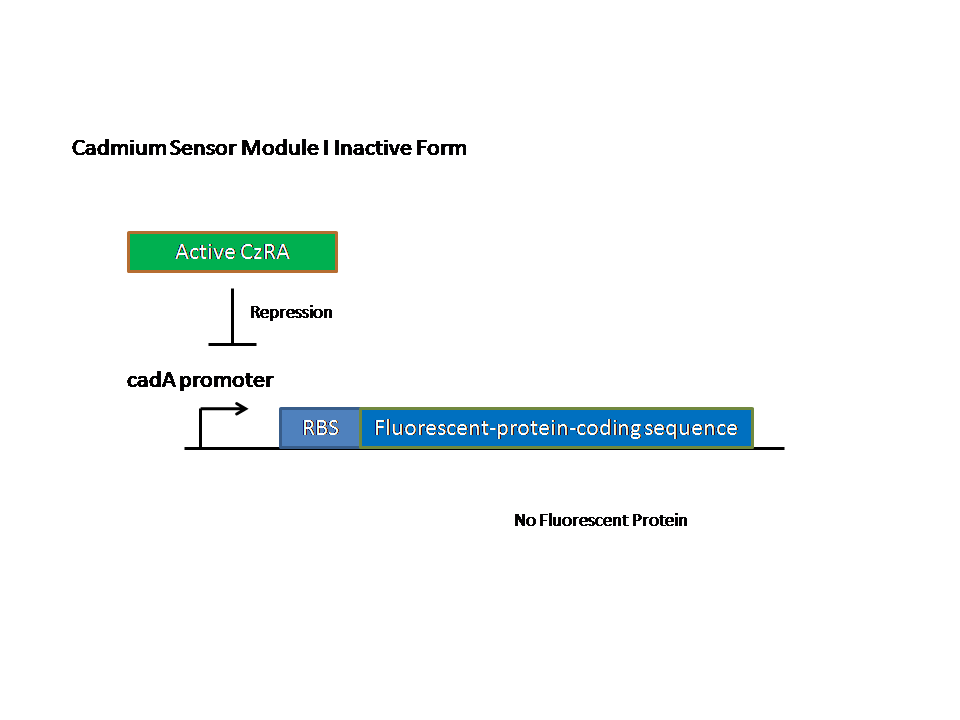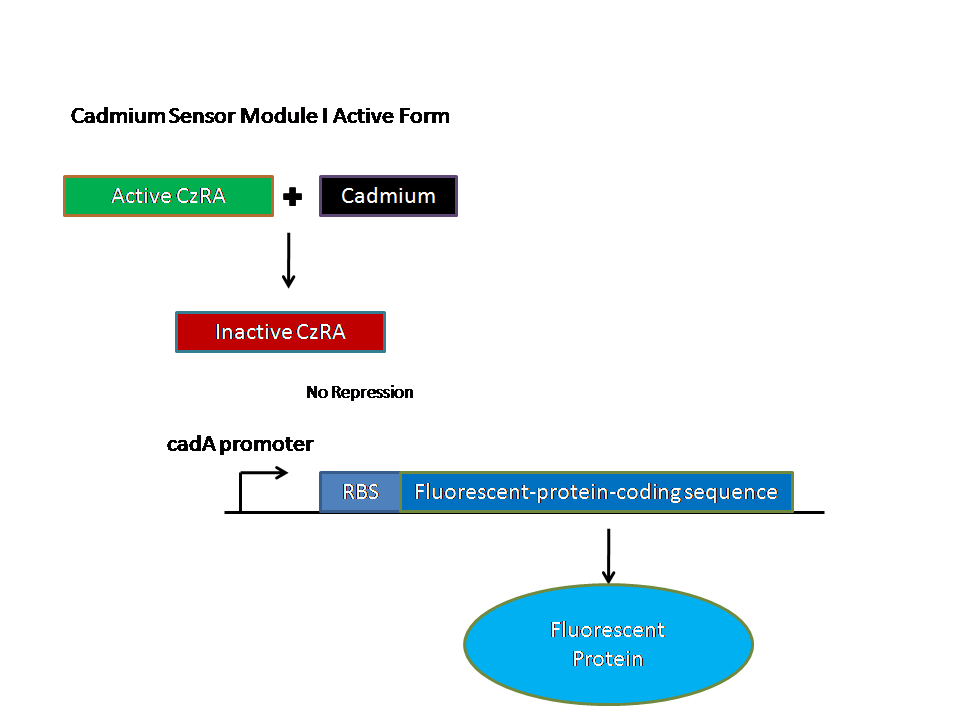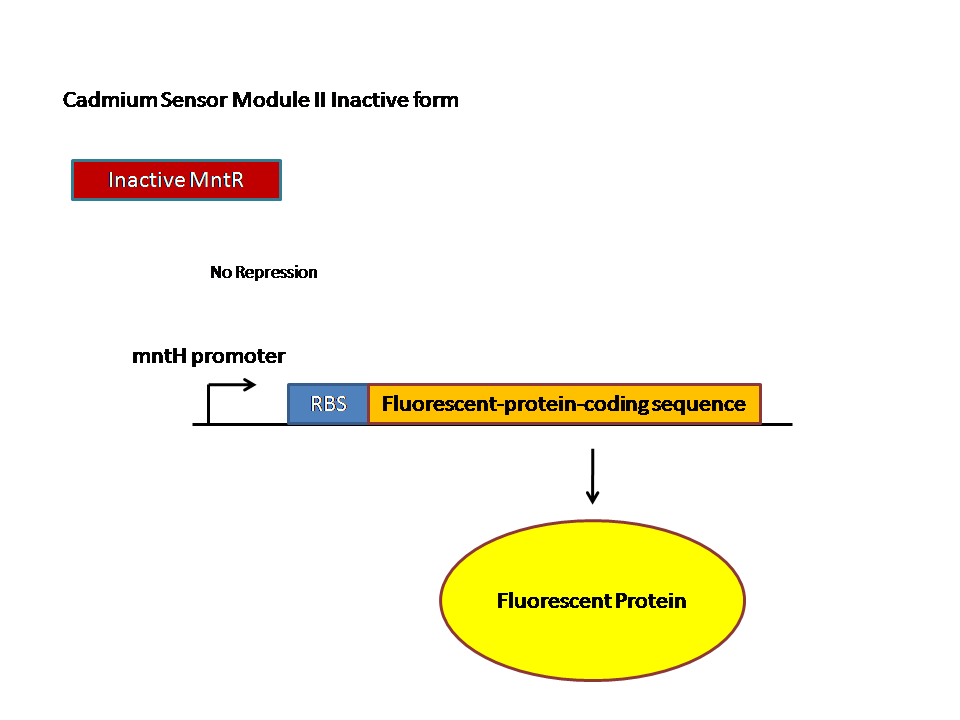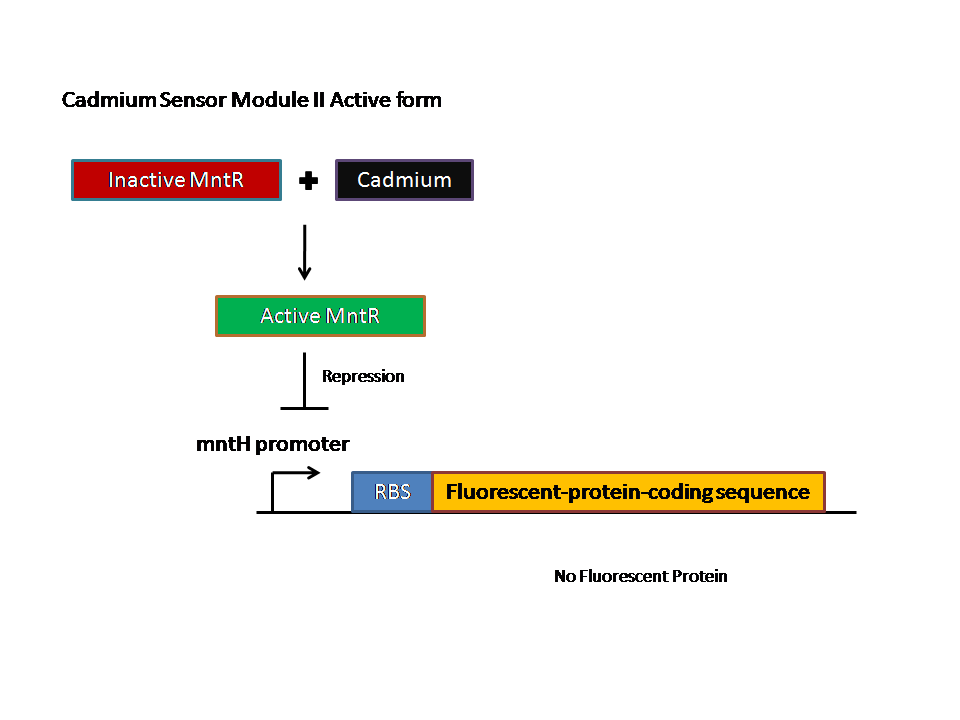Team:Cornell/Project
From 2009.igem.org
(→Cadmium Detection Module 1) |
|||
| Line 35: | Line 35: | ||
'''[Briefly describe the two modules and the differences between them]''' | '''[Briefly describe the two modules and the differences between them]''' | ||
| - | ==Cadmium | + | ==Cadmium Sensor Module 1== |
Our first cadmium sensing module utilizes the regulatory region of cadA, which activates transcription in the presence of Cd(2+). By attaching this regulatory region to an appropriate ribosome binding site and the gene for Cyan Fluorescent Protein (BBa_E0020), the production of CFP becomes a function of intracellular Cd(2+) concentration. Measuring the peak emission wavelength of CFP at 476 nm will allows us to indirectly measure the intracellular Cd(2+) concentration. As intracellular Cd(2+) concentrations rise we expect to see an increase in fluorescence at the peak emmission wavelength for CFP. | Our first cadmium sensing module utilizes the regulatory region of cadA, which activates transcription in the presence of Cd(2+). By attaching this regulatory region to an appropriate ribosome binding site and the gene for Cyan Fluorescent Protein (BBa_E0020), the production of CFP becomes a function of intracellular Cd(2+) concentration. Measuring the peak emission wavelength of CFP at 476 nm will allows us to indirectly measure the intracellular Cd(2+) concentration. As intracellular Cd(2+) concentrations rise we expect to see an increase in fluorescence at the peak emmission wavelength for CFP. | ||
Revision as of 02:08, 22 October 2009
BackgroundCadmium ContaminationCadmium (Cd) is a toxic heavy metal which has no known biological function. Ingestion of Cd-contaminated water can induce diarrhea, severe vomiting, bone fracture (Itai-Itai disease), infertility, damage to the central nervous and immune systems, cancer development and ultimately death. Once affected by Cadmium, there is no effective treatment for humans (Agency for Toxic Substances and Disease Registry). For instance, in late 20th century Japan, cadmium contamination of water in the Jingzu River led to significant kidney problems and Itai-Itai bone disease in a fairly large population. In another study, Cd concentration was directly related to mortality rate.[1] Of late, Cadmium levels have been better controlled by industrial regulation, but it still poses formidable problems. The Environmental Protection Agency (EPA) has set cadmium level regulations at a maximum of 5µg/L in drinking water. Of the 1,669 hazardous waste sites on the EPA's National Priorities List (NPL), 1,014 contain Cadmium. The Australian National Pollutant Inventory (NPI) has ranked Cd number 6 out of 400 of the most toxic substances based on health and environmental hazards and human and environmental exposure to the substance. According to the NPI, Cd has a total hazard rating of 4.3 as compared to 2.8 for Carbon Monoxide and 4.0 for Arsenic. Major sources of Cd contamination include fertilizers, sewage sludge, manure and atmospheric deposition. The amount of Cd released into the environment from human activities has actually been about 10 times greater than the amount predicted from natural sources.[2] Likewise, the amount of Cd released into the agricultural environment has also increased significantly over the last century.[3] In fact, Cd-contaminated sewage is often used for irrigation purposes in many parts of the world, especially in developing nations.[2] Crops grown in these Cd-contaminated soils are then sold in markets without any detoxification treatment. As of now, consuming Cd-contaminated crops is one of the greatest Cadmium-related problems for humans. In a study conducted in Faisalabad in Pakistan, it was found that untreated sewage used for irrigation had contamination levels that were three times the allowed level (0.03 mg.L−1 as compared to 0.01 mg.L−1) for irrigation water. Furthermore, the study found that consuming crops grown in these Cd-contaminated soils for extended periods of time can cause high levels of Cd to accumulate in humans which would lead to a number of illnesses.[2] Since similar irrigation methods are used in a number of other developing countries, it would be extremely useful to have a simple method of measuring Cadmium levels in water before using it for mass irrigation purposes. Recently developed cadmium detection methods include transmission-based localized surface plasmon resonance (LSPR) fiber-optic probes[4], prompt gamma-ray neutron activation analysis (PGNAA) [5], and a solid surface fluorescence based flow-through optosensor[6] have been developed to determine cadmium ion concentration, but the cost efficiencies of such instruments significantly exceed the cost of a simple bacterial biosensor. Metal Ion Homeostasis in BacteriaResistance mechanisms: Some heavy metals, such as manganese, iron and zinc, are essential to micro-organisms as trace nutrients, in contrast to others such as cadmium and lead, which have no known beneficial roles. However, all heavy metals are toxic at high (micro- or millimolar) concentrations. Yet it is widely known that certain bacteria are capable of growing in metal contaminated areas. These bacteria are usually adapted to the presence of toxic metals by genetically encoded resistance mechanisms, whose expression is precisely regulated. Specifically, these resistance mechanisms towards many toxic metals work by excretion of the metal by an energy-dependent pump in the cell membrane. DesignChassisBacillus Subtillis is a gram-positive bacteria, 5-10uM in length. The reason it was chosen to be used for this project was that it contains a complex metal-ion homeostasis system. This system was the basis of our biosensor. Also, B. Subtillis cells have a well characterized genome and are naturally competent, allowing for a relatively simple transformation method. Proposed DesignTo create a biosensor dependent on Cd(II) concentration, we decided to engineer the existing metal ion homeostasis system in Bacillus subtilis, in which metal ion transport is tightly regulated. The organism requires trace amounts of metals for normal growth, while high levels interfere with cellular processes. Cd(2+) enters B. subtilis through the manganese ion influx protein MntH. Intracellular Cd(2+) concentration is regulated by several factors, one of which is the CadA efflux protein. CadA is a P-type ATPase that pumps out Cd(2+). Transcription of the cadA gene is regulated by protein CzrA (formerly YozA), a ArsR/SmtB family repressor. CzRA binds and represses the cadA regulatory region and is released when bound by cadmium ions. [7] [Briefly describe the two modules and the differences between them] Cadmium Sensor Module 1Our first cadmium sensing module utilizes the regulatory region of cadA, which activates transcription in the presence of Cd(2+). By attaching this regulatory region to an appropriate ribosome binding site and the gene for Cyan Fluorescent Protein (BBa_E0020), the production of CFP becomes a function of intracellular Cd(2+) concentration. Measuring the peak emission wavelength of CFP at 476 nm will allows us to indirectly measure the intracellular Cd(2+) concentration. As intracellular Cd(2+) concentrations rise we expect to see an increase in fluorescence at the peak emmission wavelength for CFP. Cadmium Detection Module 2Our second cadmium sensing module is based on the transcription of the Mn(2+) and Cd(2+) influx protein MntH. MntH is part of MntR regulon which is downregulated in the presence of Cd(2+).[1] By using regulatory region of mntH and attaching to an appropriate ribosome binding site and Yellow Fluorescent Protein(BBa_E0030), we can use this module as another measure of the intracellular Cd(2+) concentration. As intracellular Cd(2+) concentrations rise, we expect to see a decrease in fluorescence at the peak emission wavelength for YFP at 527 nm. By using two modules we can enhance our signal to noise ratio and cancel out stochastic error in our readings. The regulatory proteins for both are modules are not completely specific to the Cd(2+) ion. In order to correct for false positive readings we will compare our fluorescence measurements to baseline values in cells induced without Cd(2+).
References[1]T. Ishihara, E. Kobayashi, Y. Okubo, Y. Suwazono, T. Kido, M. Nishijyo, H. Nakagawa and K. Nogawa (2001), Association between cadmium concentration in rice and mortality in the Jinzu river basin, Japan, Toxicology 163, p.23-28 [2]Qadir, A. Ghafoor and G. Murtaza (2000), Cadmium Concentration in Vegetables Grown on Urban Soils Irrigated with Untreated Municipal Sewage, Environment, Development and Sustainaility 2(1), p.13-21. [3]Jones, K.S., Jackson, A. and Johnston, A.E (1992), Evidence for an increase in the Cd content of herbage since the 1860s, Environ. Sci. Technol. 26, p.834-836 [4]Lin, Tsao-Jen, and Mon-Fu Chung (2009), Detection of Cadmium by a Fiber-Optic Biosensor Based on Localized Surface Plasmon Resonance, Biosensors and Bioelectronics 24(5), p.1213-8. [5]Grazman, B.L., and Schweikert, E.A (2005). A brief review of the determination of cadmium by prompt gamma-ray neutron activation analysis. Journal of Radioanalytical and Nuclear Chemistry 152(2), p.497 – 506 [6]Garcia-Reyes et al. Sensing of trace amounts of cadmium in drinking water using a single fluorescence-based optosensor. Microchemical Journal 82(1), p.94-99 [7]Helmann, John D., Qiang Que (2000), Manganese homeostasis in Bacillus subtilus is regulated by MntR, a bifunctional regulator related to the diphtheria toxin repressor family of proteins. Molecular Microbiology 35(6), p.1454-1468 Helmann, John D., Charles M. Moore, Ahmed Gaballa, Monica Hui, Rick W. Ye (2005), Genetic and physiological responses of Bacillus subtilis to metal ion stress. Molecular Microbiology 57(1), p.27-40 |
 "
"




